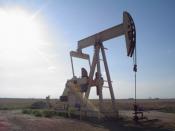Petroleum is an oily flammable liquid composed by hydrocarbons, which is found
naturally beneath the Earth's surface by drilling wells, and it is usually
called crude oil. The color of petroleum can be colorless, which is usually
for gasoline, and heavy black which is high in asphalt content. It consists of
a mixture of hydrocarbons, with traces of various nitrogenous and sulfurous
compounds.
50-90% of petroleum is hydrocarbons and the remaining is composed chiefly of
organic compounds containing oxygen, nitrogen, or sulfur. Pennsylvania crude
oils contain 97-98% hydrocarbons, but some oil from California contains only 50%
of hydrocarbons.
Oil is generally in sedimentary basins, and there are three types of basins. 1)
Rock particles from sand to clay mud, which were eroded from hills and
mountains, 2) biochemical and chemical precipitates such as limestone, gypsum,
anhydrite, 3 ) organic matter from plants and animals which lived in the sea or
carried by rivers.
The modern petroleum industry began in 1859, when the American oil pioneer E. L.
Drake drilled a producing well on Oil Creek in Pennsylvania at a place that
later became Titusville. Many wells were drilled in the region. Kerosene was the
chief finished product, and kerosene lamps soon replaced whale oil lamps and
candles. Little use other than as lamp fuel was made of petroleum until the
development of the gasoline engine and its application to automobiles, trucks,
tractors, and airplanes. Today the world is heavily dependent on petroleum for
motive power, lubrication, fuel, dyes, drugs, and many synthetics.
During the past 600 million years decayed plant and animal remains have become
buried under thick layers of rock. It is believed that petroleum consists the
remains of these organisms. The small microscopic plankton organism remains
are largely responsible for the high organic carbon content of fine-grained
sediments like the Chattanooga shale which are the biggest source rocks for
petroleum. The leading producers of petroleum are the United States, Venezuela,
Iran, Kuwait, Libya, Iraq, Saudi Arabia, Indonesia, Russia, and Romania. The
largest area for petroleum is in the Middle East.
Because of the subterranean origin of petroleum, it must be extracted by wells.
Until an exploratory well has been dug, there is no sure way of knowing whether
or not petroleum exists under the particular place. In order to reduce the
number of exploratory wells drilled, there are scientific methods that are used
to pick the most likely places. Sensitive instruments are used, such as the
gravimeter, the magnetometer, and the seismograph, to find subsurface rock
formations that can hold crude oil. Drilling is a difficult and a risky process.
Some wells must be dug several miles deep before petroleum deposits are reached.
Many are now drilled offshore from platforms standing in the ocean bed. Usually
the petroleum from a new well will come to the surface under its own pressure.
Later the crude oil must be pumped out or forced to the surface by injecting
water, gas, or air into the deposits.
The widespread use of petroleum has created serious environmental problems. The
great quantities that are burned as fuels generate most of the air pollution in
industrialized countries, and oil spilled from tankers and offshore wells has
polluted oceans and coastlines.


